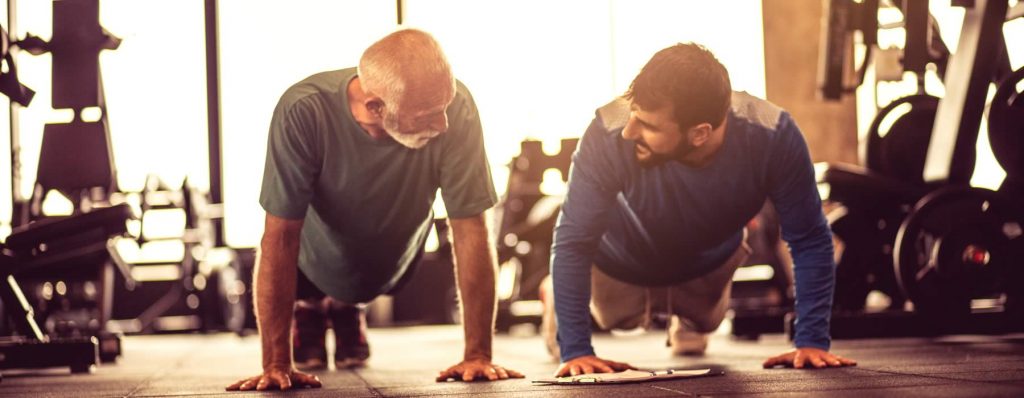
When we, as fitness trainers, design training programs for clients we have to consider many things. For example, overall strength, aerobic capacity, flexibility, fitness level and the training age of the client. Training age is considered the length of time a person has continuously exercised in their life, as compared to their chronological age.
Older adults should have a varied program including cardio, resistance, flexibility and balance or cognitive type exercises. So, to get the best results it makes sense to include exercises that are suited to the individual.
In the next few articles I will look at exercises that will deliver the best bang for a buck. To make it easier for you, and me, I will separate them into four areas.
I am going to call it, “Very or super important exercises for older people and probably everyone.”
Part One: Resistance Exercises
Today we are going to look at resistance exercises.
Definition
Resistance exercises mean you have to well resist something, such as a weight, band, kettlebell or even just your own body. When we do this, it builds muscle. Not to become big like Arnie but to build strong, lean muscle mass.
What does this do?
- It holds your body together – as in good core strength, providing you with better balance.
- It helps you with daily activities, even those such as getting out of a chair.
- They help with keeping your bone mass up.
- Help you keep your weight down, as muscles cells are the ones that burn energy.
So here are some of the exercises I think will be important in your exercise program.
Supine Bridge / Glute Bridge
So, the glute bridge is an easy exercise to perform but can be a difficult one to do properly. Make sure a qualified trainer shows you how to do it.
It targets the glutes or butt, the hamstrings and the lower back. You will also get a core workout as well. These are super important for posture and movement.
All this from one easy exercise. A key one in your armoury.
Squat: Partial, from a Chair or Free
The squat is one of the best exercises to do. A compound movement that targets the lower body. Quads, butt and thigh muscles are all given a workout. The great thing about this exercise is that you can always add to it by adding a shoulder press, to make it a complete all over body exercise.
Why should you do these daily? Because if you want to be able to get out of that chair, walk, run or jog, then build your strength with squats.
Squat with Press
Okay, as I said before, let’s add something extra. Grab some dumbbells and add a shoulder press to the finish of the squat. Great value for money in one movement.
Push Up
Everyone knows the push up. It gives your upper body a real going over. The chest, shoulders and triceps are in the firing line. Also, the core will get stronger. Just make sure you do them correctly and get a trainer to watch you, otherwise you can hurt that lower back.
One of the best things about the push up is that you can modify it. If a full push up is too hard, then go on to your knees or even do them against the wall. If you want to make it harder, then add some weight with a weight vest or even a plate over the shoulders. In other words, this is a great exercise and very versatile.
Bent Over Row
While the push up looks after your chest, the row attends to your upper back muscles, which is important for posture. Why so important? Well above all, no stooping of the shoulders. Standing upright gives the organs a chance to operate properly, and good posture reduces the risk of tripping or falling.
One of the other reasons I like it, is because you can use anything to do it, from dumbbells, kettlebells, barbells, anything will do.
Reverse Lunge Assisted
Here explained beautifully by by stack.com is why the reverse lunge must be in your kitbag.
During the Step-Back Lunge, the back remains extended, reducing pressure on the lumbar spine and maintaining a neutral center of gravity, ensuring stability.
Lunging backwards places the athlete in a more powerful position since the front leg is parallel to the floor.
The shin is more vertical during the Step-Back Lunge, with the knee a good distance back from the toes.
Stepping back allows the athlete to get deeper into the Lunge while maintaining adequate joint angles for optimum power.
The Step-Back Lunge ensures that pressure stays on the heel, whereas the momentum of the Forward Lunge is more likely to shift the pressure to the ball of the foot.
The calf is more contracted during the Forward Lunge, illustrating that more pressure is toward the toe, compromising the knee.
So, these are six of the best. There are others, of course but these will get you going and cover most of the muscle groups in your body.
Next week I’ll look at great cardio training.
Again, send me a message. I love to chat about health and fitness.
In upcoming articles:
- Very important cardio exercises
- Very important flexibility
- Very important others nerves and balance